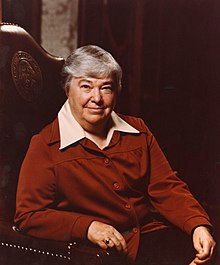Dixie Lee Ray
| Dixy Lee Ray | |
|---|---|
 |
|
| 17th Governor of Washington | |
|
In office January 12, 1977 – January 14, 1981 |
|
| Lieutenant | John Cherberg |
| Preceded by | Daniel Evans |
| Succeeded by | John Spellman |
| Assistant Secretary of State for Oceans and International Environmental and Scientific Affairs | |
|
In office January 19, 1975 – June 20, 1975 |
|
| President | Gerald Ford |
| Preceded by | Position established |
| Succeeded by | Frederick Irving |
| Chairperson of the Atomic Energy Commission | |
|
In office February 6, 1973 – January 18, 1975 |
|
| President | Richard Nixon |
| Preceded by | James Schlesinger |
| Succeeded by | Position abolished |
| Personal details | |
| Born |
Marguerite Ray September 3, 1914 Tacoma, Washington, U.S. |
| Died | January 2, 1994 (aged 79) Fox Island, Washington, U.S. |
| Resting place | Fox Island Cemetery Fox Island, Washington |
| Political party | Democratic |
| Alma mater |
Mills College Stanford University |
| Signature | |
Dixy Lee Ray (September 3, 1914 – January 2, 1994) was an American scientist and politician who served as the 17th Governor of the U.S. state of Washington. Variously described as idiosyncratic, and "ridiculously smart," she was the state's first female governor and was known for her leadership of the state during the devastating 1980 eruption of Mount St. Helens, for her strident support of atomic energy, and for her personal eccentricities.
A graduate of Mills College and Stanford University, where she earned a doctorate in biology, Ray became an associate professor at the University of Washington in 1957. She was chief scientist aboard the schooner SS Te Vega during the International Indian Ocean Expedition. Under her guidance, the nearly bankrupt Pacific Science Center was transformed from a traditional, exhibit-oriented museum to an interactive learning center, and returned to solvency.
In 1973 Ray was appointed chairman of the United States Atomic Energy Commission (AEC) by President Richard M. Nixon. Under her leadership, research and development was separated from safety programs, and Milton Shaw, the head of the powerful reactor development division, was removed. She was appointed Assistant Secretary of State for Oceans and International Environmental and Scientific Affairs by President Gerald Ford in 1975, but resigned six months later, complaining about lack of input into department decision making.
To the surprise of many, Ray ran for election as Governor of Washington as a Democrat in 1976. She won the election despite her blunt, sometimes confrontational, style. As governor, she approved allowing supertankers to dock in Puget Sound, championed support for unrestrained growth and development, and continued to express enthusiasm for atomic energy. On April 3, 1980 she declared a state of emergency as a result of the volcanic eruption of Mount St. Helens. She retired after losing her bid for re-election in 1980.
...
Wikipedia
